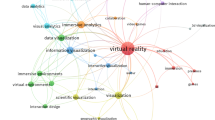Abstract
Virtual reality (VR) can provide useful tools for a variety of applications. However, for these tools to be effective, they must be easy to use. In virtual environments (VEs), usability is impaired by poorly designed navigation systems. Insufficient realism and missing physiological orientation and motion cues impair spatial learning in desktop VEs. Capabilities for navigation in a VE are far more varied than in reality; so much greater flexibility can be offered, but designing VEs with too many options can overwhelm users. To assist designers in building effective, usable navigation systems for VEs, navigation techniques must be evaluated to identify which features actually support users in accomplishing their tasks and which features create unnecessary problems.
This study evaluates navigation in two different VEs to develop recommendations for the design of navigation systems in desktop VEs. The study consists of an objective assessment of navigation control dynamics, a guideline-based evaluation and a review of data collected during two experimental studies. The findings indicate that real-world constraints, specialised navigation techniques and feedback regarding location and direction of travel are needed to support navigation in desktop VEs.



Similar content being viewed by others
References
Baker MP, Wickens CD (1995) Human factors in virtual environments for the visual analysis of scientific data. Technical report, NCSA-TR032, University of Illinois, National Center for Supercomputer Applications, Urbana-Champaign, Illinois
Bowman DA (1999) Interaction techniques for common tasks in immersive virtual environments: design, evaluation, and application. Doctoral dissertation, Georgia Institute of Technology, Atlanta, Georgia
Bowman DA, Davis ET, Hodges LF, Badre AN (1999) Maintaining spatial orientation during travel in an immersive virtual environment. Presence-Teleop Virt 8(6):618–631
Bowman DA, Kruijff E, LaViola Jr JJ, Poupyrev I (2001) An introduction to 3D user interface design. Presence-Teleop Virt 10(1):96–108
Brooke J (1996) SUS: a ‘quick and dirty’ usability scale. In: Jordan PW, Thomas B, Weerdmeester B, McClelland IL (eds) Usability evaluation in industry. Taylor and Francis, London
Chapanis A (1972) Design of controls. In: Van Cott H, Kinkade R (eds) Human engineering guide to equipment design, revised edn. Wiley, New York
Darken R, Sibert J (1996) Navigating in large virtual worlds. Int J Hum-Comput Int 8(1):49–72
Drøivoldsmo A, Louka MN (2002) Virtual reality tools for testing control room concepts. In: Tiptak B (ed) Instrument engineers’ handbook: process software and digital networks, vol 3, 3rd edn. CRC Press LLC, Florida, USA
Drøivoldsmo A, Nystad E, Helgar S (2001) Virtual reality verification of workplace design guidelines for the process plant control room. Halden work report, HWR-633. OECD Halden Reactor Project, Halden, Norway
Gabbard JL, Hix D (1997) A taxonomy of usability characteristics in virtual environments. Report for the Office of Naval Research, grant number N00014-96-1-0385. Department of Computer Science, Virginia Polytechnic Institute and State University, Blacksburg, Virginia
Henry D, Furness D (1993) Spatial perception in virtual environments: evaluating an architectural application. In: Proceedings of the IEEE virtual reality annual international symposium (VRAIS ‘93), Lausanne, Switzerland, pp 33–40
Kolasinski EM (1996) Prediction of simulator sickness in a virtual environment. Doctoral dissertation, University of Central Florida, Orlando, Florida
Nielsen J (1993) Usability engineering. Academic Press, Boston, Massachusetts
Norman DA (1990) The design of everyday things. MIT Press, Cambridge, Massachusetts
Nystad E, Drøivoldsmo A, Sebok A (2002) Use of radiation maps in a virtual training environment for NPP field operators. Halden work report, HWR-681. OECD Halden Reactor Project, Halden, Norway
Nystad E, Helgar S, Drøivoldsmo A (2002) Virtual reality verification of workplace design guidelines: a follow-up study. Halden work report, HWR-718. OECD Halden Reactor Project, Halden, Norway
Quill LL, Schopper AW (1993) Graphical presentation of nuclear power plant concepts, status, information and data. CSERIAC-RA-93–011. Crew System Ergonomics Information Analysis Center, Wright Patterson Air Force Base, Ohio
Ruddle RA, Jones D (2001) Movement in cluttered virtual environments. Presence-Teleop Virt 10(5):511-524
Sanders MS, McCormick EJ (1993) Human factors in engineering and design, 7th edn. McGraw-Hill, London
Sayers HM, Wilson S, Myles W, McNeill MDJ (2000) Usable interfaces for virtual environment applications on non-immersive systems. In: Proceedings of the Eurographics UK conference 2000, pp 143–150
Schiffman HR (1990) Sensation and perception: an integrated approach, 3rd edn. Wiley, New York
Siegel AW, White SH (1975) The development of spatial representations of large-scale environments. In: Reese HW (ed) Advances in child development and behaviour, vol 10. Academic Press, New York
Stanney KM, Hash P (1998) Locus of user-initiated control in virtual environments: influences on cybersickness. Presence-Teleop Virt 7(5):447–459
Thorndyke PW, Hayes-Roth B (1982) Differences in spatial knowledge acquired from maps and navigation. Cognitive Psychol 14(4):560–589
Vinson NG (1999) Design guidelines for landmarks to support navigation in virtual environments. In: Proceedings of the ACM SIGCHI conference on human factors in computing systems (CHI ‘99), Pittsburgh, Pennsylvania, May 1999, pp 278–285
Witmer BG, Kline PB (1998) Judging perceived and traversed distances in virtual environments. Presence-Teleop Virt 7(2):144–167
Witmer BG, Sadowski WJ (1998) Nonvisually guided locomotion to a previously viewed target in real and virtual environments. Hum Factors 40(3):478–488
Woods DD (1984). Visual momentum: a concept to improve the cognitive coupling of person and computer. Int J Man Mach Stud 21(3):229–244
Author information
Authors and Affiliations
Corresponding author
Rights and permissions
About this article
Cite this article
Sebok, A., Nystad, E. & Helgar, S. Navigation in desktop virtual environments: an evaluation and recommendations for supporting usability. Virtual Reality 8, 26–40 (2004). https://doi.org/10.1007/s10055-004-0133-1
Received:
Accepted:
Published:
Issue Date:
DOI: https://doi.org/10.1007/s10055-004-0133-1




